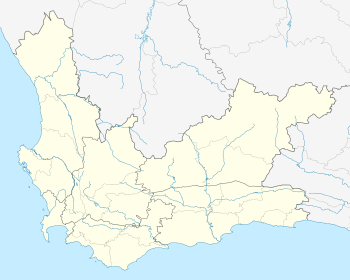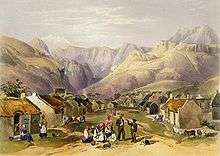Genadendal
| Genadendal | |
|---|---|
|
Genadendal Moravian Mission Station, founded in 1737 | |
 Genadendal  Genadendal Genadendal (South Africa)  Genadendal Genadendal (Africa) | |
| Coordinates: 34°02′S 19°33′E / 34.033°S 19.550°ECoordinates: 34°02′S 19°33′E / 34.033°S 19.550°E | |
| Country | South Africa |
| Province | Western Cape |
| District | Overberg |
| Municipality | Theewaterskloof |
| Established | 1738 |
| Area[1] | |
| • Total | 3.97 km2 (1.53 sq mi) |
| Population (2011)[1] | |
| • Total | 5,663 |
| • Density | 1,400/km2 (3,700/sq mi) |
| Racial makeup (2011)[1] | |
| • Black African | 3.1% |
| • Coloured | 94.0% |
| • Indian/Asian | 0.3% |
| • White | 0.5% |
| • Other | 2.1% |
| First languages (2011)[1] | |
| • Afrikaans | 94.9% |
| • English | 3.1% |
| • Other | 2.0% |
| Time zone | UTC+2 (SAST) |
| Postal code (street) | 7234 |
| PO box | 7234 |
| Area code | 028 |

Genadendal [χəˈnɑːdəndal] is a town in the Western Cape province of South Africa, built on the site of the oldest mission station in the country. It was originally known as Baviaanskloof.[2]
Location
Genadendal (Valley of Grace) is approximately 90 minutes drive east of Cape Town in the Riviersonderend Mountains.
History
Genadendal has a rich spiritual history and was the first mission station in southern Africa. It was founded by Georg Schmidt, a German missionary of the Moravian Church, who settled on 23 April 1738 in Baviaans Kloof (Ravine of the Baboons) in the Riviersonderend Valley and began to evangelise among the Khoi people.[3] The Moravian Church (originated in 1457 in Moravia, today part of the Czech Republic) had a particular zeal for mission. Many thought that mission work among the Khoisan was attempting the impossible, but in spite of this Schmidt prevailed. He became acquainted with an impoverished and dispersed Khoi people who were practically on the threshold of complete extinction. Apart from the few Kraals, which still remained, there were already thirteen farms in the vicinity of Baviaans Kloof. Within a short while Schmidt formed a small Christian congregation. He taught the Khoi to read and write, but when he began to baptise his converts there was great dissatisfaction among the Cape Dutch Reformed Church clergy.[4] According to them, Schmidt was not an ordained minister and as such, was not permitted to administer the sacraments. Consequently, he had to abandon his work, and in 1744, after seven years at Baviaans Kloof, he left the country.[5]
Genadendal Residence, the official Cape Town residence of the President of South Africa, is named after the town.[6]
Books about Genadendal
- Bernhard Krüger, "The Pear Tree Blossom. The history of the Moravian Church in South Africa."
References
- 1 2 3 4 "Main Place Genadendal". Census 2011.
- ↑ "Dictionary of Southern African Place Names (Public Domain)". Human Science Research Council. p. 71.
- ↑ Giliomee, Hermann; Mbenga, Bernard (2007). New History of South Africa. Tafelberg. pp. 98–99.
- ↑ Giliomee, Hermann; Mbenga, Bernard (2007). New History of South Africa. Tafelberg. pp. 98–99.
- ↑ Giliomee, Hermann; Mbenga, Bernard (2007). New History of South Africa. Tafelberg. pp. 98–99.
- ↑ Weber, Rebecca (11 December 2013). "Revisiting Nelson Mandela's Genadendal". USA Today. Retrieved 6 December 2015.
.svg.png)